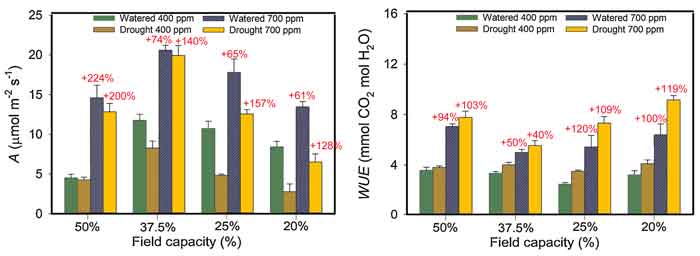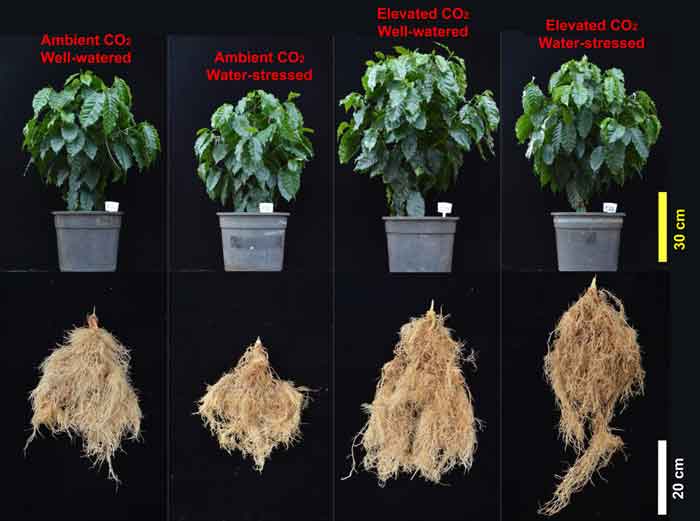| Tweet | Follow @co2science |
Paper Reviewed
Avila, R.T., de Almeida, W.L., Costa, L.C., Machado, K.L.G., Barbosa, M.L., de Souza, R.P.B., Martino, P.B., Juáárez, M.A.T., Marcal, D.M.S., Martins, S.C.V., Ramalho, J.D.C. and DaMatta, F.M. 2020. Elevated air [CO2] improves photosynthetic performance and alters biomass accumulation and partitioning in drought-stressed coffee plants. Environmental and Experimental Botany 177: 104137.
Climate alarmists predict plants will face increasing abiotic stresses in the future in consequence of CO2-induced global warming, such as higher temperatures and more frequent and severe episodes of drought, which could severely impact ecosystem health world wide. And so the research community routinely investigates the potential impacts of these predicted outcomes in an effort to ascertain what the future holds for the world's flora.
One recent study in this regard is that of Avila et al. (2020), who examined the effect of water stress on coffee plants (Coffea arabica, cv. IAC 44) at ambient and elevated CO2 levels. More specifically, they exposed coffee seedlings to ambient (400 ppm) or elevated (700 ppm) CO2 levels during the hours of 0600 to 1800 each day inside a controlled-environment greenhouse for seven months. During the first five months all plants received adequate water (soil water content maintained near field capacity). Thereafter, half of the plants were exposed to drought stress that progressively worsened with time (after an initial reduction in soil water content to 50% field capacity the soil water content was further reduced to 37.5%, 25% and ultimately 20% until the completion of the experiment two months later). The seven-month-old plants were then evaluated and harvested for analysis.
And what did the experiment reveal?
In the words of the authors, the results demonstrate elevated CO2 "improved carbon assimilation, water use efficiency and biomass accumulation regardless of watering," which favorable impacts are visually illustrated in Figures 1 and 2 below. It was determined that the aforementioned CO2-induced growth and water use enhancements tended to be higher under water-stressed as opposed to well-watered conditions. For example, elevated CO2 enhanced plant total dry matter by 32% under well-watered conditions, but by a much larger 59% under drought-stressed conditions. Avila et al. also determined that there were "no signs of photosynthetic downregulation" in the coffee plants exposed to elevated CO2 and that higher CO2 levels reduced plant oxidative stress/damage.
Commenting on their findings, the authors say they "offer novel and timely information on the mitigating ability of elevated air [CO2] on the photosynthetic performance and growth under drought stress conditions," which information they add "is of utmost importance in the context of the present and future climate change scenarios for the coffee crop sustainability." Indeed, and such news of a total amelioration of drought stress is great news for those concerned about model-predictions of future climate.

Figure 1. The effect of watering (well-watered or drought-stressed plants) and CO2 supply (400 or 700 ppm) on the net photosynthetic rate (left panel) and water-use efficiency (right panel) of coffee plants. Measurements were made at 50, 37.5, 25 and 20 % of field capacity for the drought-stressed plants. The percentages in red text indicate the change in photosynthesis or water use efficiency due to atmospheric CO2 for a given water treatment (i.e., well-watered or drought). Source: Avila et al. (2020).

Figure 2. Representative phenotypic appearance of shoot and roots of coffee plants exposed to different combinations of ambient or elevated CO2 and well-watered or drought-stressed conditions. Source: Avila et al. (2020).




